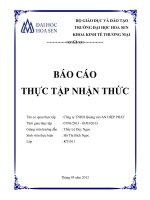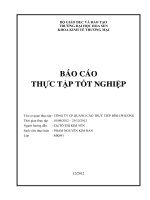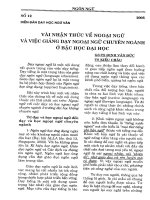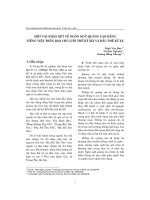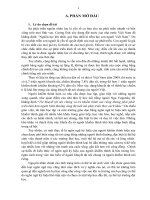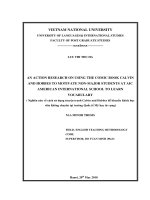nhận thức về ngon ngữ quảng cao dưới goc nhin ẩn dụ ý niệm
Bạn đang xem bản rút gọn của tài liệu. Xem và tải ngay bản đầy đủ của tài liệu tại đây (367.71 KB, 10 trang )
TẠP CHÍ KHOA HỌC VÀ CÔNG NGHỆ, ĐẠI HỌC ĐÀ NẴNG - SỐ 1(42).2011
NHẬN THỨC VỀ NGÔN NGỮ QUẢNG CÁO DƯỚI GÓC NHÌN
CỦA ẨN DỤ Ý NIỆM
COGNITION OF ADVERTISING LANGUAGE IN THE VIEW
OF CONCEPTUAL METAPHOR
Phan Văn Hòa
Huỳnh Trung Ngữ
Trường Đại học Ngoại ngữ, Đại học Đà Nẵng
Học viên cao học khóa 2007-2010
TÓM TẮT
Ngày nay ẩn dụ không còn là vấn đề của riêng ngôn ngữ mà ẩn dụ là vấn đề của tư duy và
hành động. Ẩn dụ không chỉ giới hạn ở các tác phẩm văn chương mà trái lại nó được sử dụng trong
hầu hết tất cả các lĩnh vực bởi tính thiết thực của nó. Quan điểm về ẩn dụ khái niệm của Lakoff và
Johnson [1] đã mở ra những hướng nghiên cứu mới về ẩn dụ. Quảng cáo là một mãnh đất màu mỡ
để ẩn dụ có thể phát triển vì những nhu cầu thiết thực của mục đích quảng cáo. Trong bài viết này
các tác giả bước đầu đề cập đến việc nhận thức về ngôn ngữ quảng cáo dưới góc nhìn của ẩn dụ
khái niệm. Trước hết, xác định lại khái niệm ẩn dụ ý niệm, thứ hai là chỉ ra vai trò của ẩn dụ ý niệm
đối với giao tiếp nói chung và đối với ngôn ngữ quảng cáo nói riêng, thứ ba là nói đến bốn chủ đề
ẩn dụ ý niệm thường xuất hiện trong quảng cáo; đó là hành trình, chiến tranh, bè bạn, và quà tặng.
Trong khi mô tả và phân tích mỗi chủ đề như vậy, người viết sẽ so sánh cách sử dụng ẩn dụ ý niệm
cũng như tầng số xuất hiện của các chủ đề đề này thông qua ẩn dụ ý niệm trong tiếng Anh và trong
tiếng Việt. Cuối cùng, người viết sẽ nhận xét chung và đưa ra những đề xuất ứng dụng.
ABSTRACT
Metaphor is not only the matter of language but also that of thoughts and actions. The
fact that metaphor is almost used in all fields is due to its effectiveness, not only in literary
works. When Lakoff’s and Johnson’s theory was introduced, it opened a new horizon for the
study of metaphor. Conceptual metaphor has come into our everyday life under different
aspects and adverting language is one of them. In this paper, the writers want to discuss the
cognition of advertising language in the view of conceptual metaphor. Firstly, the definition of
the concept ‘the conceptual metaphor’ is restated. Secondly, the role of conceptual metaphor
regarding communication in general and advertising language in particular is pointed out.
Thirdly, the four topics such as Journeys, Wars, Friends, and Gifts, which are commonly
mapped through advertisements, are described and analyzed. In this way, comparisons of
conceptual metaphor expressions and of occurrences in English and Vietnamese are made.
Finally, some general comments and practical suggestions are also presented in this article.
1. Introduction
Nowadays, advertising is a part that is inevitable in the modern life because our
present society is that of producers and consumers. Advertising is not only means of
selling goods, but also a level of art, and in its turn, because of the level of art,
advertising becomes more effective for selling products. This is also the reason why
metaphor is used more and more in advertising. In other words, advertisers have paid
more attention to ways of using words and their meaning effectively in order to serve
218
TẠP CHÍ KHOA HỌC VÀ CÔNG NGHỆ, ĐẠI HỌC ĐÀ NẴNG - SỐ 1(42).2011
producers’ aims. But how they explore conceptual metaphors to benefit themselves in
terms of the use of metaphor is a question to be answered. We will come to the
following examples:
(1) Địa ốc SaigonLand: Điểm hẹn của sự thành công!
[7]
(2) FPT: Cùng đi tới thành công
[7]
(22) UPS: Moving at the speed of business
[10]
(27) Microsoft: Where Do You Want to Go Today?
[11]
From the examples above, we can see the presence of conceptual metaphor in
advertising via metaphor expressions like “Điểm hẹn”, “Cùng đi tới”, “Moving at the
speed”, “Go”. Here, we see the source domain [JOURNEY] in order to send
advertisers’ massages to consumers. So, we grasp advertising language thanks to these
metaphorical expressions.
We will come to the definition of conceptual metaphor to understand more about
its nature as well as its role in advertising.
2. Conceptual Metaphor
2.1 Definition
In studies of metaphor, the representation of any coherent segment of
experience, such as the concepts of love or journeys, a conceptual domain that is
understood in terms of another is called a conceptual metaphor. In other words, in the
cognitive linguistic view, metaphor is defined as understanding one conceptual domain
in terms of another conceptual domain. Examples of this include when we talk and think
about life in terms of journeys, about arguments in terms of wars, about love also in
terms of journeys, about theories in terms of buildings, about ideas in terms of food,
about social organizations in terms of plants, and many others. A convenient shorthand
way of capturing this view of metaphor is the following: CONCEPTUAL DOMAIN
(A) is CONCEPTUAL DOMAIN (B) [1], which is what is called a conceptual
metaphor. This idea, and a detailed examination of the underlying processes, was first
extensively explored by George Lakoff and Mark Johnson in “Metaphors We Live By”
[1]. Cognitive scientists often study subjects similar to conceptual metaphor under the
label of "analogy." Take some examples below to clarify the concept: conceptual
metaphor.
Examples:
o
o
o
o
o
o
o
Life is a journey (Cuộc sống là một hành trình)
Love is a journey (Tình yêu là một hành trình)
Love is a war (Tình yêu là một cuộc chiến tranh)
Argument is a war (Tranh luận là một cuộc chiến tranh)
Theory is a building (Lý thuyết là một tòa nhà)
Idea is a food (Ý tưởng là một món ăn)
Time is money (Thời gian là tiền bạc) [1]
219
TẠP CHÍ KHOA HỌC VÀ CÔNG NGHỆ, ĐẠI HỌC ĐÀ NẴNG - SỐ 1(42).2011
2.2 Mappings
There are two main types of conceptual domains used in conceptual metaphors:
Source domain: the conceptual domain from which we draw metaphorical expressions.
Target domain: the conceptual domain that we try to understand.
A mapping is the systematic set of correspondences that exist between
constituent elements of the source and the target domain. Many elements of target
concepts come from source domains and are not preexisting. To know a conceptual
metaphor is to know the set of mappings that applies to a given source-target pairing.
We can see that the set of concept in which words and expressions is borrowed is called
“Source Model”, while the concept which is the borrowers is called “Target Model” as
shown in the examples.
Source Model
Target Model
[JOURNEY]
Traveler
Destinations
[LIFE]
She went through life with a good heart.
He knows where he is going in life.
Routes
I don’t know which path to take…
3. The role of conceptual metaphors in advertising
Leiss, Kline, and Jhally [3] have used metaphor to study social communication
in advertising. They suggest that metaphors in advertisements have become a powerful
and commonly used strategy, when saying: “Metaphor is the very heart of the basic
communication form used in advertising”. Many other researchers share this view as
they seek to explain the effects of metaphor use in advertising.
The study of metaphor in advertising has been used to gain insight about
consumer behavior [6]. Zaltman’s Metaphor Elicitation Technique (ZMET) was a
research tool developed to define and describe the metaphors that drive consumer
behavior with implications for copy testing [6]. Metaphors are relevant to the study of
advertising because metaphors are laden with symbols and imagery that might be used
creatively in implementing decisions that will animate or bring appropriate reasoning
processes and mental models to life.
Stern [5] also is an advocate of studying symbolism along with metaphor
in advertising. Stern believes that advertising is a metaphorical art, much like
poetry [5].
Phan Văn Hòa [4: 9] says: “Metaphor is not the use of a special language to
decorate something with beautiful but empty words. In contrast, metaphor has long
become a real essence and emotion of language life in various kinds of discourse. Nor
is metaphor limitted to the use of imaginary words. But, rather, metaphor has entered
220
TẠP CHÍ KHOA HỌC VÀ CÔNG NGHỆ, ĐẠI HỌC ĐÀ NẴNG - SỐ 1(42).2011
into the process of ‘wording’ of the conceptual world. Metaphor is not only an effective
means of language but also a creative thinking device based on the featurique function
of language”.
4. Presence of conceptual metaphors in advertising
4.1 Journeys
The source domain [JOURNEY] is used to conceptualize advertising language.
Through metaphorical expressions, we perceive advertising language under different
aspects. From the various mappings, we see the ontological correspondent entities
between two domains the source and the target as follows:
Producers, products, goods, activities, and services are travellers on a journey.
Also, services or advertised products are pathways along which consumers move.
Activities and transactions are movements made on journeys. Again, advertised
products also are the departures or destinations of journeys, etc.
We have a look at some following examples:
(1) Daily Mirror: Forward with the People
[10]
(2) Coca-cola: Station of the Stars
[10]
(3) Pot Noodle: Fuel of Britain, Isn’t It
[11]
(4) 1939 - Coca-Cola goes along.
[12]
(5 Địa ốc SaigonLand: Điểm hẹn của sự thành công!
[7]
(6) FPT: Cùng đi tới thành công
[7]
(7) “Con đường tốt nhất vào Đại học hàng đầu thế giới.”
[9]
From the examples above, we see the languages of journeys are borrowed to
describe the sub-domains of the target domain [ADVERTISING]. So, we understand
advertising language via language of journey. For example, the phrases “Forward
with”, “Station”, “ Fuel”, “ goes along”, “ Điểm hẹn”, “ Cùng đi tới”, “ Con đường
tốt nhất” are use metaphorically to depict the advertised products and services lively
and aptly. From “Forward with” in (1), we understand that the paper Daily Mirror
always companies with the people like friends on a journey. With the metaphorical
expression “Station” in (2), the product Coca-cola is understood drink loved and chosen
by the Stars. Or Pot Noodle is considered fuel of Britain via the word “Fuel” in (3)
while Địa ốc SaigonLand is seen as a destination for people through “Điểm hẹn” in (5).
And, the service FPT ia depicted as a traveler on a journey via the metaphorical
expression “Cùng đi tới” in (6) and so on. There are many metaphorical expressions
belonging the source [JOURNEY] used in English and Vietnamese. We have a
comparison via the following table.
221
TẠP CHÍ KHOA HỌC VÀ CÔNG NGHỆ, ĐẠI HỌC ĐÀ NẴNG - SỐ 1(42).2011
Table 4.1. Metaphorical expressions belong to the source model [JOURNEY]
in English and Vietnamese
English
Vietnamese
Blue Ginger Restaurant: A nice place to come
Anh văn Hội Việt Mỹ: Khởi đầu cho sự thành công
Hat Council: If you want to get ahead, get a hat
Địa ốc SaigonLand: Điểm hẹn của sự thành
công!
Pampers: We’re right behind you. Every step of
the way
FPT: Cùng đi tới thành công
After all, can you think of a better way to avoid
manual labour? Sabura
Trường Nhân lực Quốc tế: Vững bước đến tương
lai!
You're invited on a Journey
Con đường tốt nhất vào Đai học hàng đầu thế giới.
4.2. Wars
Like the previous way of metaphor use, the advertisers have used the war
metaphor in their advertisements to make advertising language more lively and stronger.
The war metaphor also has another version the fight metaphor, and this metaphor
generates many entailments. Advertising is often presented in terms of wars or fighting
as physical conflict or clash between adversaries. As a result, there is a tight mapping
according to which entities in the domain of advertising systematically correspond to
entities in the domain of fighting. This mapping preserves the image-schematic structure
of the source domain [2] because the image schematic structure of the source domain
[WAR] is projected onto the target domain [ADVERTISING]. The ontological
correspondences are the following:
Actions or activities in advertisements are fights, struggles, or combats. Those
activities take place in the course of fighting. Products, services, and advertised
things are hostile enemies in the market. They fight each other to get their own
markets and customers. So, companies, products, goods, and advertised things
have become brave warriors or soldiers in an army. Competition between
products advertised is the confrontation between counterparts. That products
used most welcomed warmly by virtue of their quality and convenient use is
victory, whereas that the ones welcomed less or boycotted by consumers
because of bad quality is defeat in the battle. Sometimes, the fights occur
between products’ use and the agents attacking people. As a result, advertised
products become warriors willing to fight to protect people from attacking of
unexpected agents.
The following is some examples for illustration:
222
(8) Budweiser Beer: Nothing beats a Budweiser
[7]
(9) Nivea: It helps protect your skin.
[7]
TẠP CHÍ KHOA HỌC VÀ CÔNG NGHỆ, ĐẠI HỌC ĐÀ NẴNG - SỐ 1(42).2011
(10) You Can Kill a Horse but not a Cadillac
[13]
(11) Milmax Angle 2 với Lactoferrin: Lá chắn vững chắc cho
thiên thần của bạn
[7]
(12) Kem Nivea Q10 Plus: Đẩy lùi mọi dấu hiệu lão hóa
[7]
(13) Thật xứng danh thủ lĩnh Plasma siêu việt
[8]
From the examples above, we see that advertising language is understood in
terms of the language of wars. For example, with the word “beat” used
metaphorically in (8), Budweiser Beer is considered a strong warrior that can’t be
beaten by anyone. From here, we can understand that Budweiser Beer is a champion
of quality in comparison with other beers. Or, the product Nivea Cream Q10 Plus is
considered a soldier that can stop and drive back every sign of old-age. This is
depicted via “Đẩy lùi” in (12) and so forth. The conceptual metaphor is used in both
English and Vietnamese.
Table 4.2. Metaphorical expressions belong to the source model [WAR] in English and in Vietnamese
English
Budweiser
Budweiser
Beer:
Vietnamese
Nothing
beats
a Milmax Angle 2 với Lactoferrin: Lá chắn
vững chắc cho thiên thần của bạn
Quaker Puffed Rice: Shot from Guns!
Kem Nivea Q10 Plus: Đẩy lùi mọi dấu
hiệu lão hóa
You Can Kill a Horse but not a Cadillac
“…Cao huyết áp được mệnh danh là kẻ
giết người thầm lặng…”
Mineral Care Spa Hydra-Free-OilBiore: Look closely. No cleaner clears Balance giúp kiểm soát chất nhờn tối đa
and prevents blemishes better than Biore và chống mất nước cho da, mang lại cho
bạn một làn da sạch,…
Pond’s Double White Day and Night
Sally Hansen Nailpolish: The protection
Facial Foam giúp loại bỏ bụi bẩn, bã
you need in the colors you want
nhờn…
Nivea: It helps protect your skin.
Prudential Financial:
protecting your wealth
Growing
Nụ cười chiến thắng cùng EPSON
and
Thật xứng danh thủ lĩnh Plasma siêu việt
Nicorette: Nicorette, Nicorette, you can Clear: “Trong thế giới của tóc, gàu bắt
beat the cigarette
đầu xâm chiếm…”
223
TẠP CHÍ KHOA HỌC VÀ CÔNG NGHỆ, ĐẠI HỌC ĐÀ NẴNG - SỐ 1(42).2011
4.3. Friends
The model [FRIEND] is used as the source domain to express the massages
from the everyday advertisements. The friend metaphor has large metaphorical
entailments, so there are many different aspects from friends used metaphorically to
persuade consumers. The following are illustrated examples in English and Vietnamese:
(14) IZUSU: Always besides you
[7]
(15) Kodak: Share moments. Share life
[7]
(16) Transcend (USB): Digital life in your hand. Your supplier,
Your partner, Your friend
[7]
(17) Bảo Việt Việt Nam: Cùng bạn trên mọi nẻo đường
[7]
(18) MiLo: Giúp trẻ tự tin để vươn xa hơn
[7]
(19) Biti’s: Nâng niu bàn chân Việt
[7]
The examples above let us see that due to the metaphorical expressions from
(14) to (19) like “Always besides you”, “Share”, “Your friend”, “Cùng bạn”, “Giúp
trẻ”, “Nâng niu” advertised products and services have become close consumers’
friends that can share, help and always stand beside consumers. As a result, the
advertisers have built an amicable relationship between the advertised products as well
as producers and consumers. There is similarity between English and Vietnamese in
using this metaphor.
Table 4.3. Metaphorical expressions belong to the source model [FRIEND]
in English and in Vietnamese
English
Vietnamese
IZUSU: Always besides you
Bảo Việt Việt Nam: Cùng bạn trên mọi nẻo
đường
Transcend (USB): Digital life in your hand. Your
supplier, Your partner, Your friend
Thái Sơn – người bạn trung thành và chuyên
nghiệp của bạn
Kodak: Share moments. Share life
Bảo hiểm Prudential: Luôn luôn lắng nghe,
luôn luôn thấu hiểu
Pampers: We’re right behind you. Every step of the
way
Người lao động – Tờ báo luôn đồng hành với
đời sống và việc làm của bạn.
Access: Your Flexible Friend
Hãy chọn kỳ nghỉ tuyệt vời cho bạn cùng Hàng
không Singapore.
4.4. Gifts
Human beings’ life has been developing together with the course of time, so giving
and receiving gifts become a part of everyday communication means. Catching this trend,
the advertisers have exploited the source model [GIFT] to project onto the conceptual
224
TẠP CHÍ KHOA HỌC VÀ CÔNG NGHỆ, ĐẠI HỌC ĐÀ NẴNG - SỐ 1(42).2011
domains in advertising. With the structural mapping, the advertisers want to draw
consumers’ feelings and care to the advertised products as well as seduce perspective
customers to buy their products, goods, and services. The following is examples:
(20) General Electric: We Bring Good Things to Life
[7]
(21) They'll Take The Cadillac Tonight!
[7]
(22) Bơ Lisa: Món quà từ thiên nhiên
[7]
(23) Nước khoáng thiên nhiên Thạch Bích: Quà tặng vô giá của thời gian
[7]
Through conceptual metaphors, advertised products and services are considered
valuable gifts that attract everyone. We can see this from the examples above. And, we
don’t find out any difference between English and Vietnamese.
Table 4.4. Metaphorical expressions belong to the source model [GIFT] in English
and in Vietnamese
English
Vietnamese
Anheuser-Busch Beer: This Bud’s for
Bơ Lisa: Món quà từ thiên nhiên
You
Kleenex:
Kleenex
Thank
goodness
for
Đồng hồ Rado: Hãy bày tỏ tình yêu của bạn
bằng cách tặng đồng hồ Rado
ALPO Dog Foot: Doesn’t your dog Nước khoáng thiên nhiên Thạch Bích: Quà
deserve ALPO?
tặng vô giá của thời gian
Arpege perfume: Promise
anything, but give her Arpege!
her
“Nhân sâm là món quà vô giá mà tạo hóa
đã ban tặng cho con người…”
5. Conceptual metaphors are most commonly used in English and Vietnamese
5.1. Conceptual Metaphors are most Commonly used in English
From the samples studied, we find that all three types of conceptual metaphors:
structural metaphors, ontological metaphors, and orientational metaphors are used in
advertising via different source models, but their frequency is not the same. The
statistics are shown in the table 5.1 below:
Table 5.1. Frequency of occurrence of types of conceptual metaphors in English
Type of metaphor
Quantity
Percentage
Structural metaphors
116
46.4%
Ontological metaphors
119
47.6 %
Orientational metaphors
15
6%
Total
250
100.00
225
TẠP CHÍ KHOA HỌC VÀ CÔNG NGHỆ, ĐẠI HỌC ĐÀ NẴNG - SỐ 1(42).2011
5.2. Conceptual Metaphors are most Commonly used in Vietnamese
While the Ontological metaphors are most commonly used in English, the
Structural metaphors are most employed in Vietnamese as shown in the table 5.2 below.
Table 5.2. Frequency of occurrence of types of conceptual metaphors in Vietnamese
Type of metaphor
Quantity
Percentage
Structural metaphors
171
68.4%
Ontological metaphors
67
26.8%
Orientational metaphors
12
4.8%
Total
250
100.00
Figure 5.2: Frequency of occurrence of types of conceptual metaphors in Vietnamese
5%
27%
Structural metapho rs
Onto lo gical metapho rs
Orientatio nal metapho rs
68%
5.3. Summary
Conceptual metaphor used in advertising is an amusing phenomenon of
language. There are many different source domains used to conceptualize advertising
language, but within the limit of the paper, writers only introduce four popular source
domains that are used almost in all advertisements: Journeys, Wars, Friends, and Gifts.
In these source domains, we see that although there are differences in terms of the
frequency of occurrence of conceptual metaphors in English and Vietnamese, linguistic
features are almost analogous in the two languages. However, there are more other
domains should be paid more attention in the study of conceptual metaphors. To cover
the use of conceptual metaphors will give us more benefits: the nature of conceptual
meataphors will be clarified; and when clarified, conceptual metaphors will be widely
exploited not only in advertising but also in all kinds of discourses.
226
TẠP CHÍ KHOA HỌC VÀ CÔNG NGHỆ, ĐẠI HỌC ĐÀ NẴNG - SỐ 1(42).2011
TÀI LIỆU THAM KHẢO
[1] Lakoff, George and Johnson (1980), M. Metaphors We Live By, Chicago and
London: The University of Chicago Press.
[2] Lakoff, George , The Invariance Hypothesis: Is Abstract Reason Based on Image
Schemas?, Cognitive Linguistics,1, 1990, 9-74.
[3] Leiss, W., Kline, S., and Jhally, S. (1986), Social Communication in Advertising.
New York: Methuen.
[4] Phan Văn Hòa (2008), “Ẩn dụ, ẩn dụ dụng học và ẩn dụ ngữ pháp”, Ngôn ngữ và
đời sống, số 5.
[5] Stern, Barbara, “Medieval Allegory: Roots of Advertising Strategy for the Mass
Market. Journal of Marketing 52.3, 1988, 84-94.
[6] Zaltman, Gerald and Coulter, Robin, “Seeing the Voice of the Consumer:
Metaphor-Based Advertising Research.”, Journal of Advertising Research 35.4
July/August, 1995, 35-51
TÀI LIỆU PHÂN TÍCH
[7] Phan Thị Uyên Uyên, An investigation into some commonly stylistic devices in
advertising language in English and Vietnamese newspapers, MA. Thesis, 2006.
[8] Thanh Niên, N0 363 (Dec 29th 2009), N0 07 (Jan 07th 2010)
[9] Tuổi Trẻ, N031/01/2010, N0 25/02/2010, N0 31/03/2010
[10] />[11] />[12] />[13] />
227



